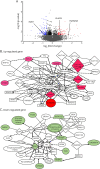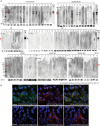GRP78 Antibodies Are Associated With Blood-Brain Barrier Breakdown in Anti-Myelin Oligodendrocyte Glycoprotein Antibody-Associated Disorder
- PMID: 34725263
- PMCID: PMC8561843
- DOI: 10.1212/NXI.0000000000001038
GRP78 Antibodies Are Associated With Blood-Brain Barrier Breakdown in Anti-Myelin Oligodendrocyte Glycoprotein Antibody-Associated Disorder
Abstract
Background and objectives: To analyze (1) the effect of immunoglobulin G (IgG) from patients with anti-myelin oligodendrocyte glycoprotein antibody (MOG-Ab)-associated disorder on the blood-brain barrier (BBB) endothelial cells and (2) the positivity of glucose-regulated protein 78 (GRP78) antibodies in MOG-Ab-associated disorders.
Methods: IgG was purified from sera with patients with MOG-Ab-associated disorder in the acute phase (acute MOG, n = 15), in the stable stage (stable MOG, n = 14), healthy controls (HCs, n = 9), and disease controls (DCs, n = 27). Human brain microvascular endothelial cells (BMECs) were incubated with IgG, and the number of nuclear NF-κB p65-positive cells in BMECs using high-content imaging system and the quantitative messenger RNA change in gene expression over the whole transcriptome using RNA-seq were analyzed. GRP78 antibodies from patient IgGs were detected by Western blotting.
Results: IgG in the acute MOG group significantly induced the nuclear translocation of NF-κB and increased the vascular cell adhesion molecule 1/intercellular adhesion molecule 1 expression/permeability of 10-kDa dextran compared with that from the stable MOG and HC/DC groups. RNA-seq and pathway analysis revealed that NF-κB signaling and oxidative stress (NQO1) play key roles. The NQO1 and Nrf2 protein amounts were significantly decreased after exposure to IgG in the acute MOG group. The rate of GRP78 antibody positivity in the acute MOG group (10/15, 67% [95% confidence interval, 38%-88%]) was significantly higher than that in the stable MOG group (5/14, 36% [13%-65%]), multiple sclerosis group (4/29, 14% [4%-32%]), the DCs (3/27, 11% [2%-29%]), or HCs (0/9, 0%). Removal of GRP78 antibodies from MOG-IgG reduced the effect on NF-κB nuclear translocation and increased permeability.
Discussion: GRP78 antibodies may be associated with BBB dysfunction in MOG-Ab-associated disorder.
Copyright © 2021 The Author(s). Published by Wolters Kluwer Health, Inc. on behalf of the American Academy of Neurology.
Figures






Similar articles
-
Small Nuclear Ribonucleoprotein Autoantibody Associated With Blood-Nerve Barrier Breakdown in Guillain-Barré Syndrome.Neurol Neuroimmunol Neuroinflamm. 2025 Jul;12(4):e200405. doi: 10.1212/NXI.0000000000200405. Epub 2025 May 19. Neurol Neuroimmunol Neuroinflamm. 2025. PMID: 40388674 Free PMC article.
-
Comparison of myelin oligodendrocyte glycoprotein (MOG)-antibody disease and AQP4-IgG-positive neuromyelitis optica spectrum disorder (NMOSD) when they co-exist with anti-NMDA (N-methyl-D-aspartate) receptor encephalitis.Mult Scler Relat Disord. 2018 Feb;20:144-152. doi: 10.1016/j.msard.2018.01.007. Epub 2018 Jan 31. Mult Scler Relat Disord. 2018. PMID: 29414288 Review.
-
Relevance of antibodies to myelin oligodendrocyte glycoprotein in CSF of seronegative cases.Neurology. 2019 Nov 12;93(20):e1867-e1872. doi: 10.1212/WNL.0000000000008479. Epub 2019 Oct 23. Neurology. 2019. PMID: 31645473
-
Clinical spectrum and IgG subclass analysis of anti-myelin oligodendrocyte glycoprotein antibody-associated syndromes: a multicenter study.J Neurol. 2017 Dec;264(12):2420-2430. doi: 10.1007/s00415-017-8635-4. Epub 2017 Oct 23. J Neurol. 2017. PMID: 29063242 Free PMC article.
-
Blood-Brain Barrier Disruption in Neuroimmunological Disease.Int J Mol Sci. 2024 Oct 2;25(19):10625. doi: 10.3390/ijms251910625. Int J Mol Sci. 2024. PMID: 39408955 Free PMC article. Review.
Cited by
-
Physiological Roles of the Autoantibodies to the 78-Kilodalton Glucose-Regulated Protein (GRP78) in Cancer and Autoimmune Diseases.Biomedicines. 2022 May 24;10(6):1222. doi: 10.3390/biomedicines10061222. Biomedicines. 2022. PMID: 35740249 Free PMC article. Review.
-
Age-associated changes in gene expression in the anterior pituitary glands of female Japanese black cattle.Mamm Genome. 2022 Dec;33(4):606-618. doi: 10.1007/s00335-022-09958-9. Epub 2022 Jul 15. Mamm Genome. 2022. PMID: 35838775
-
Pathogenic autoantibodies in multiple sclerosis - from a simple idea to a complex concept.Nat Rev Neurol. 2022 Nov;18(11):681-688. doi: 10.1038/s41582-022-00700-2. Epub 2022 Aug 15. Nat Rev Neurol. 2022. PMID: 35970870 Review.
-
Update on the diagnosis and treatment of neuromyelits optica spectrum disorders (NMOSD) - revised recommendations of the Neuromyelitis Optica Study Group (NEMOS). Part I: Diagnosis and differential diagnosis.J Neurol. 2023 Jul;270(7):3341-3368. doi: 10.1007/s00415-023-11634-0. Epub 2023 Apr 6. J Neurol. 2023. PMID: 37022481 Free PMC article. Review.
-
Jo-1 Antibodies From Myositis Induce Complement-Dependent Cytotoxicity and TREM-1 Upregulation in Muscle Endothelial Cells.Neurol Neuroimmunol Neuroinflamm. 2023 May 5;10(4):e200116. doi: 10.1212/NXI.0000000000200116. Print 2023 Jul. Neurol Neuroimmunol Neuroinflamm. 2023. PMID: 37147138 Free PMC article.
References
-
- Cobo-Calvo A, Vukusic S, Marignier R. Clinical spectrum of central nervous system myelin oligodendrocyte glycoprotein autoimmunity in adults. Curr Opin Neurol. 2019;32(3):459-466. - PubMed
-
- Reindl M, Jarius S, Rostasy K, Berger T. Myelin oligodendrocyte glycoprotein antibodies: how clinically useful are they? Curr Opin Neurol. 2017;30(3):295-301. - PubMed
Publication types
MeSH terms
Substances
LinkOut - more resources
Full Text Sources
Miscellaneous
